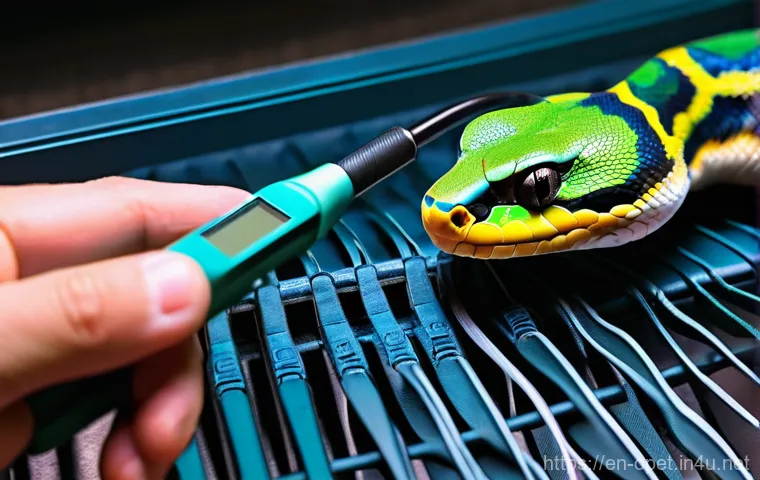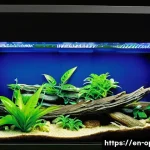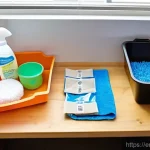Hey there, fellow reptile enthusiasts! You know that unique joy of watching your scaly friend thrive, right? A huge part of that comes down to getting their environment just right, and when it comes to temperature, it’s definitely not a one-size-fits-all situation.
I’ve personally seen the difference a few degrees can make for everything from my bearded dragon’s activity levels to my gecko’s digestion, and honestly, it’s a game-changer!
Each amazing species has its own thermal sweet spot, and understanding those nuanced needs is absolutely key to their health and happiness. If you’ve ever found yourself scratching your head over basking spots or nighttime drops, you’re in the right place, because providing the perfect climate is simpler than you think.
Let’s make sure your reptile is living its best, coziest life and get those temperature controls absolutely spot on!
Understanding Your Reptile’s Inner Thermostat: Why Every Degree Matters

More Than Just Comfort: The Science Behind Optimal Temperatures
Hey there, awesome reptile parents! We all want our scaled buddies to be happy and healthy, right? And when it comes to keeping them thriving, getting their temperature just right isn’t just about comfort—it’s absolutely critical for their very survival. Think about it: our cold-blooded friends can’t generate their own body heat like we do. They rely entirely on their environment to regulate their internal temperature, which impacts everything from their metabolism to their immune system. I remember when I first got my leopard gecko, Luna. I thought “room temperature” was good enough, but boy, was I wrong! She became sluggish, stopped eating, and I was genuinely worried. Once I dialed in her heat gradient, it was like a whole new gecko emerged—active, hunting, and vibrant. It truly hammered home for me that proper heating isn’t a luxury; it’s a fundamental necessity. It dictates how efficiently they digest food, how quickly they can flee from perceived threats, and even how well their bodies can fight off illness. A few degrees too hot or too cold can genuinely mean the difference between a flourishing pet and one struggling to survive.
Decoding Their Behavior: Reading the Thermal Cues
One of the coolest parts about owning reptiles is learning to understand their subtle communication, especially when it comes to temperature. They can’t exactly tell us if they’re too warm or too chilly, so it’s up to us to become expert interpreters of their body language. I’ve spent countless hours just observing my corn snake, Monty, and my bearded dragon, Spike, and you pick up on so much. If your bearded dragon is constantly gaping with its mouth open, even outside of a basking session, it might be trying to release excess heat – a clear sign that its basking spot or ambient temps are too high. Conversely, if your snake is always coiled up under the heat lamp and refusing to explore, it could be struggling to get warm enough. Over-basking, hiding constantly on the cool side, or even changes in activity levels and appetite are all vital clues. When I noticed Luna spending all her time crammed into the warmest corner, I realized her cool side wasn’t quite cool enough, forcing her to seek the only suitable spot. Learning these behaviors helps us fine-tune their environment, ensuring they can thermoregulate naturally and comfortably throughout their enclosure.
Crafting the Perfect Sunbeam: Mastering the Basking Spot
The Goldilocks Zone: Why Hot Isn’t Always Better
Ah, the basking spot! For many reptiles, this is the absolute epicenter of their world. It’s where they soak up those essential UVB rays and absorb heat to kickstart their day. But here’s the kicker: it’s not about making it as hot as possible. We’re looking for that “Goldilocks Zone” – not too hot, not too cold, but just right. For many species, especially desert dwellers like bearded dragons, this means a distinct hot spot that can reach significantly higher temperatures than the ambient air. I’ve tried various lamps over the years, from mercury vapor bulbs to ceramic heat emitters, and the key is consistent, measured heat. I personally use a temperature gun for spot checks, not just a thermometer on the wall, because it gives me an immediate, accurate reading of the surface temperature where Spike actually basks. Too hot, and you risk burns or overheating; too cool, and they can’t properly digest food or synthesize vitamin D. It’s a delicate balance that often requires a bit of experimentation and, most importantly, diligent monitoring. Always remember to provide a gradient so they can move in and out of the most intense heat as needed.
Placement is Everything: Designing a Functional Gradient
Creating a truly effective basking area goes beyond just having a heat lamp; it’s about thoughtful placement within the context of your entire enclosure’s thermal gradient. Imagine their natural habitat: the sun isn’t just one intense beam; there are shady spots, partially exposed areas, and full sun. Your enclosure should mimic this. The basking spot should typically be at one end of the enclosure, establishing a warm side, and gradually fading to a cooler side at the opposite end. This allows your reptile to choose exactly where they need to be to regulate their body temperature. For my chameleon, I found that placing his basking lamp a bit higher, above a sturdy branch, worked perfectly because he prefers to thermoregulate vertically, moving up and down the branches. For my tortoise, a flatter, larger basking area near a cave for cooling was ideal. It’s not just about the lamp, but the whole setup – the rocks, branches, hides, and substrate all play a role in creating those vital temperature zones. Without a proper gradient, your reptile can’t thermoregulate effectively, which can lead to chronic stress and health issues over time. It’s truly an art to get it just right, and it makes such a difference.
The Night Shift: Why Cooler Evenings Are Essential
Replicating Nature’s Rhythm: The Importance of a Temperature Drop
Just as critical as a daytime basking spot is the often-overlooked necessity of a nighttime temperature drop. In their natural habitats, the sun goes down, and temperatures inevitably fall. This diurnal cycle is hardwired into their biology, and replicating it in captivity is paramount for their long-term health. When I first started out, I was so worried about my snake getting “cold” that I kept his heat lamp on 24/7. What I didn’t realize was that a constant, unchanging temperature can actually be detrimental. Many species need that slight dip at night to rest, to allow their metabolism to slow down, and to complete certain physiological processes. Imagine trying to sleep in a scorching hot room every single night – you’d be exhausted! For my ball python, a consistent drop into the mid-70s Fahrenheit at night helps simulate his natural environment and encourages better digestion and overall well-being. Of course, this doesn’t mean letting their enclosure become frigid; we’re talking about a controlled, moderate drop, not a deep freeze. A ceramic heat emitter on a thermostat is often a perfect solution for providing warmth without light, ensuring they can enjoy their natural rhythms.
Choosing the Right Nighttime Heat Source: Light vs. No Light
When it comes to nighttime heating, the big question often revolves around light. Should you use a red bulb, a blue bulb, or no light at all? My personal recommendation, based on years of experience and extensive research, is to go with a heat source that emits no visible light. Reptiles, just like us, need a clear day-night cycle to regulate their circadian rhythms. A constant glow, even from a “night light” bulb, can disrupt their sleep patterns, cause stress, and lead to a host of health problems. I’ve heard countless stories, and observed it myself, of reptiles becoming restless or even developing eye issues from perpetual light exposure. My go-to options are ceramic heat emitters (CHEs) or radiant heat panels (RHPs). These provide excellent, consistent ambient heat without any light whatsoever, allowing your reptile to truly experience darkness. For larger enclosures or more sensitive species, an under-tank heater (UTH) connected to a thermostat can also be effective for providing belly heat. Whichever you choose, always, always pair it with a reliable thermostat to prevent overheating and ensure stable temperatures throughout the night. Your reptile will thank you for the peaceful darkness!
The Hidden Power of Humidity: A Crucial Temperature Partner
More Than Just Mist: Humidity’s Role in Respiration and Shedding
When we talk about temperature, humidity often feels like a separate topic, but trust me, they’re inextricably linked, especially for certain species. Proper humidity levels, alongside appropriate temperatures, are absolutely vital for a reptile’s respiratory health and successful shedding. Imagine a tropical species like a crested gecko or a veiled chameleon in a dry, desert-like environment – they’d struggle! Low humidity can lead to respiratory infections, difficulty shedding (which can result in retained sheds on toes and tail tips, leading to constriction and even loss of digits), and overall dehydration. I learned this the hard way with my chameleon. Her sheds were getting ragged, and I noticed a slight wheezing sound. Once I ramped up her humidity with regular misting and a proper substrate, she transformed into a much healthier, happier lizard. It’s not just about misting; it’s about creating a microclimate where humidity can fluctuate naturally, but within their species-specific range. Often, a slight increase in temperature in a humid environment can make a world of difference for comfortable breathing, especially for animals that need high humidity to thrive.
Achieving the Perfect Balance: Tools and Techniques
So, how do you hit that sweet spot for humidity without turning your enclosure into a swamp? It’s a combination of several factors, and it largely depends on the specific needs of your reptile. For my tropical species, I use a combination of a hygrometer (a must-have!) to monitor levels, a deep, moisture-retaining substrate like coco fiber or sphagnum moss, and regular misting. Some keepers use foggers or automatic misting systems, which can be fantastic for maintaining consistent levels, especially if you’re out during the day. For desert species, a water dish is often sufficient, but ensuring they have a moist hide can be a lifesaver during shedding cycles. This moist hide creates a localized pocket of higher humidity where they can retreat when needed. It’s a bit like having a sauna for your reptile! Remember, too much humidity can be just as harmful as too little, leading to bacterial or fungal infections. It’s about finding that happy medium. By understanding the interplay between temperature and humidity, we can create an environment that truly supports all aspects of our reptiles’ health, from their breathing to their skin integrity.
Your Thermal Toolkit: Essential Gadgets for Precision Control

Beyond the Stick-On: Investing in Accurate Monitoring
Alright, let’s talk gear! If you’re serious about providing the best for your reptile, you absolutely need to upgrade your temperature monitoring game. Those little stick-on thermometers? Ditch ’em. Seriously. They’re notoriously inaccurate and often only measure the temperature of the glass, not the air or basking surface. Investing in reliable equipment isn’t just a recommendation; it’s a non-negotiable for responsible reptile keeping. My personal arsenal includes a digital thermometer/hygrometer combo with probes – I place one probe on the cool side, one on the warm side, and another near the basking spot (but not directly under the lamp, which could melt it). And for that all-important basking surface temperature, an infrared temperature gun is your best friend. It gives you instant, accurate readings of specific surfaces. I use mine multiple times a day during setup and then regularly for spot checks. I learned early on that relying on guesswork or cheap gadgets leads to problems. My thermostat for my heat mat actually failed once, and if I hadn’t had a digital thermometer with an alarm function, my gecko’s hide would have gotten dangerously hot. These tools are your eyes and ears inside the enclosure.
The Lifeline: Thermostats and Dimmers for Stable Environments
Once you have your heat sources, the next crucial step is to put them on a thermostat or dimmer. This isn’t optional; it’s a safety and stability requirement. A thermostat works by turning your heat source on and off to maintain a set temperature, while a dimmer reduces the power output to the heat source. Without one, your heat lamp could easily reach dangerous temperatures, literally cooking your reptile, or your heat mat could overheat. I personally use a proportional thermostat for my main heat lamps and a dimming thermostat for my CHEs, as they provide a much more stable temperature curve than simple on/off thermostats. Never, ever plug a heat mat directly into the wall; they need a thermostat to prevent burns. The peace of mind alone is worth the investment. I remember a new keeper friend whose snake suffered severe burns because they didn’t use a thermostat with their heat mat. It was a heartbreaking lesson. These devices are the unsung heroes of reptile husbandry, ensuring that your enclosure stays within that perfect, life-sustaining range, day and night. They’re truly the backbone of a safe and stable reptile habitat.
Troubleshooting Temperature Troubles: Common Pitfalls and Smart Solutions
When Things Go Wrong: Identifying and Fixing Hot Spots and Cold Spots
Even with the best intentions and the right gear, sometimes things just don’t go according to plan. You might find yourself scratching your head wondering why your digital thermometer is reading 80F, but your reptile is still acting sluggish. This is where active troubleshooting comes in, and it often boils down to identifying hot spots or cold spots within the enclosure. Maybe your heat lamp is too close to a piece of decor, creating a dangerously hot surface that your reptile can’t escape. Or perhaps the cool side isn’t actually cool enough, especially in a smaller enclosure where heat bleed from the warm side is significant. I once thought my bearded dragon’s enclosure was fine, but a quick scan with my infrared temp gun revealed that the back wall, near his favorite rock, was actually much hotter than I anticipated, creating a tiny, unsafe hot spot. Always check temperatures at different levels and locations within the enclosure—not just at one fixed point. Sometimes, simply adjusting the height of a heat lamp, adding more ventilation, or providing extra hides can solve these issues. It’s about being observant and proactive.
Ambient vs. Surface: Understanding the Nuances of Measurement
Here’s a common point of confusion for many new keepers: the difference between ambient air temperature and surface temperature. It’s a distinction that can literally be life or death for your reptile. Ambient temperature refers to the general air temperature within the enclosure, which is important for overall comfort and health. But for basking reptiles, the surface temperature of their basking spot is equally, if not more, critical. They need to absorb heat directly from that surface. I’ve seen setups where the ambient air temperature was perfect, but the basking surface was either too cool for proper digestion or dangerously hot, risking burns. My leopard gecko, for example, needs specific belly heat for digestion, so her under-tank heater provides a warm surface, even if the ambient air isn’t super high. This is why having both a digital thermometer for ambient air and an infrared temperature gun for surface readings is non-negotiable. Without understanding both, you’re essentially flying blind. It’s like checking the room temperature in your house but forgetting to check if the stovetop is blazing hot!
Species-Specific Sweet Spots: A Tailored Approach to Thermal Care
Not a One-Size-Fits-All: Decoding Your Reptile’s Unique Needs
Okay, this is perhaps the most important takeaway from our whole discussion: there is no universal “right” temperature for all reptiles. Each species, owing to its evolutionary history and natural habitat, has a unique set of thermal requirements. A bearded dragon from the Australian deserts needs vastly different conditions than a crested gecko from the humid forests of New Caledonia, or a ball python from the savannas of West Africa. This is where doing your homework becomes absolutely crucial. Before you even bring your new scaly friend home, research their specific temperature ranges, both for their basking spot and their ambient warm and cool sides, as well as their nighttime drop. I made the mistake once of assuming my new blue-tongued skink would thrive under the same conditions as my bearded dragon – big mistake! Their needs for humidity and basking temperatures are quite different. It takes a bit of time to learn, but truly understanding their individual requirements is the cornerstone of responsible reptile husbandry. Don’t just guess; consult reliable sources, join forums, and always put your specific animal’s needs first.
A Quick Reference Guide for Common Reptiles
To help you get started, here’s a general overview of temperature ranges for some popular pet reptiles. Remember, these are guidelines, and specific needs can vary slightly by individual animal and subspecies. Always cross-reference with multiple reputable sources for your specific pet!
| Reptile Species | Basking Spot (Fahrenheit) | Warm Side Ambient (Fahrenheit) | Cool Side Ambient (Fahrenheit) | Nighttime Drop (Fahrenheit) |
|---|---|---|---|---|
| Bearded Dragon | 100-110°F | 80-85°F | 70-75°F | 68-72°F |
| Leopard Gecko | 88-92°F (belly heat) | 80-85°F | 70-75°F | 68-72°F |
| Ball Python | 88-92°F | 80-82°F | 75-78°F | 72-75°F |
| Corn Snake | 85-90°F | 78-82°F | 70-75°F | 68-72°F |
| Crested Gecko | No Basking Spot (room temp) | 72-78°F | 70-72°F | 68-70°F |
Always keep in mind that these are general figures. For instance, while a crested gecko doesn’t need a hot basking spot, they absolutely suffer if their ambient temperatures get too high. I’ve seen some heartbreaking situations where new owners accidentally roasted their cresties because they tried to apply bearded dragon temperature rules to them. It’s a stark reminder that knowledge is truly power when it comes to keeping these incredible animals healthy and happy. Research, observe, and adjust – that’s the mantra for success!
Wrapping Things Up
Whew! We’ve covered a lot of ground today, haven’t we? It truly warms my heart (and hopefully your reptile’s!) to know that you’re taking such an active interest in their thermal comfort. I genuinely hope that by sharing my own experiences and what I’ve learned over the years, you feel more confident in creating a habitat where your scaly friend can absolutely thrive. Remember, every little tweak and observation you make contributes to their well-being, and there’s nothing more rewarding than seeing them happy and healthy. Keep learning, keep observing, and keep giving your amazing reptiles the best life possible!
Handy Tips and Insights to Keep in Mind
1. Regular Thermometer Calibration is Key: Even the best digital thermometers can drift over time. I’ve made it a habit to periodically check mine against a known accurate thermometer (like a medical one, carefully used!) or even against boiling water and ice water to ensure they’re still reading correctly. A few degrees off might not seem like much, but for a delicate reptile, it can lead to chronic stress or even illness. Don’t just trust; verify, and if in doubt, replace it. It’s a small expense for big peace of mind.
2. The “Cold Side” Isn’t Just for Show: It’s tempting to focus all our energy on the basking spot, but the cool side is equally vital for thermoregulation. If the cool side of your enclosure is too warm, your reptile has no true escape from the heat, leading to overheating and dehydration. I once thought my vivarium was perfectly regulated, only to find my leopard gecko constantly trying to burrow away on the “cool” side – turns out, even there, the temperature was a touch too high, forcing her to seek artificial relief. Always ensure a true temperature gradient exists.
3. Substrate Matters More Than You Think: Your choice of substrate plays a huge role in both temperature and humidity regulation. A substrate that retains moisture, like coco fiber, can help maintain higher humidity, indirectly affecting how heat is perceived by your reptile. Conversely, a sand-based substrate in a desert setup will dissipate heat quickly, allowing for cooler burrowing. I discovered this with my tortoise; switching to a deeper, more naturalistic substrate not only improved his humidity but also allowed him to burrow down for a genuine cool-down when he needed it, mimicking his natural behaviors.
4. Beware of Thermal Bridging: This is something not many new keepers consider. Thermal bridging happens when heat travels through materials that connect hot and cold areas, making the “cold” side warmer than intended. For example, a piece of decor extending from directly under the heat lamp all the way to the cool side can conduct heat, making the cool side warmer. Always place decor strategically to maintain your established temperature zones. I once had a lovely piece of driftwood that acted like a heat sink, inadvertently creating an unsafe warm spot on what was supposed to be the coolest end of the tank.
5. Observe, Don’t Just Measure: While thermometers and hygrometers are crucial, nothing replaces careful observation of your reptile’s behavior. Are they constantly glued to the basking spot? Are they always hiding on the cool side? Are they glass surfing or gape-mouth breathing? These are all indicators that something might be off, even if your gadgets say everything is “fine.” My corn snake, Monty, is usually quite active, so when he started spending all his time in his warm hide, I knew to double-check his cool side ambient temperature, and sure enough, it had dropped too low. Your reptile’s behavior is the ultimate thermometer.
Key Takeaways
Creating the ideal thermal environment for your reptile is a non-negotiable aspect of responsible pet ownership. Remember, they depend entirely on you to provide the precise temperatures and gradients their bodies need for digestion, immune function, and overall well-being. Always research your specific species’ requirements thoroughly, investing in accurate monitoring equipment like digital thermometers with probes and an infrared temperature gun. Crucially, connect all heat sources to a reliable thermostat or dimmer to prevent dangerous overheating and ensure a stable environment, day and night. Pay close attention to both ambient and surface temperatures, and don’t forget the vital role humidity plays in conjunction with heat. By diligently setting up and maintaining these conditions, you’re not just providing comfort; you’re ensuring a long, healthy, and happy life for your cherished scaled companion. Your dedication to their environment truly makes all the difference in the world.
Frequently Asked Questions (FAQ) 📖
Q: Why is getting the temperature just right so incredibly important for my reptile’s health, and what happens if it’s too hot or too cold?
A: Oh, this is such a common and critical question, and I totally get why it’s on your mind! Think of it this way: unlike us warm-blooded folks, our reptiles can’t just crank up or dial down their internal thermostat.
They’re completely dependent on their environment to regulate their body temperature, which is why we call them “ectothermic” or “cold-blooded”. I’ve learned firsthand that when their enclosure isn’t at the right temperature, it can throw everything out of whack.
If it’s too cold, their metabolism slows way down, almost like they’re in a perpetual sluggish state. This means their digestion can suffer, leading to poor nutrient absorption and even malnutrition, no matter how good their food is!
I once had a snake regurgitate its meal because its belly heat wasn’t quite where it needed to be, and trust me, that was a clear sign I needed to re-evaluate things.
Beyond digestion, consistently low temperatures can weaken their immune system, making them super vulnerable to illnesses like respiratory infections.
They also become less active, which impacts their natural behaviors and overall well-being. It’s like us trying to function when we’re constantly shivering – not ideal!
On the flip side, too much heat is just as dangerous, if not more so, because it can be fatal quicker than you think. Overheating leads to severe dehydration, heat stress, and can even cause organ damage.
I’ve seen reptiles frantically trying to escape an enclosure that’s too hot, which is a clear distress signal. This isn’t just uncomfortable for them; it can rapidly lead to serious health issues or death.
So, maintaining that “thermal sweet spot” isn’t just about comfort; it’s about making sure their entire physiological system, from digestion to immune response, is functioning optimally.
It really boils down to giving them the tools to be their healthiest selves!
Q: I’m trying to get my setup perfect. What’s the best way to accurately measure and consistently maintain the right temperatures in my reptile’s enclosure, especially for basking spots and ambient temps?
A: This is where the rubber meets the road, isn’t it? Getting those measurements spot-on is absolutely key, and honestly, it’s a common area where new (and even some experienced!) keepers can make mistakes.
From my own experience, relying on those cheap stick-on dial thermometers is a big no-go – they’re notoriously inaccurate and can give you a false sense of security.
For ambient (air) temperature, you’ll want to invest in good quality digital thermometers. I personally use several with probes, placing them in different areas of the enclosure: one on the warm side and one on the cool side, often elevated and in a shaded area to get a true air temp reading, not a surface temp.
This gives me a clear picture of the thermal gradient my reptile has available. Brands like Zoo Med and Exo Terra offer reliable digital options, often combined with hygrometers which are super useful too.
Now, for that crucial basking spot temperature, digital probes can still be misleading if they’re touching the surface or directly in the light. The absolute best tool for measuring the surface temperature of your basking area is an infrared thermometer, often called a “temp gun”.
You simply point and shoot the laser at the exact spot your reptile would bask, and it gives you an instant, accurate surface temperature. I learned early on that the air temp above the basking spot isn’t the same as the rock temp on the basking spot, and that temp gun quickly became my best friend for peace of mind.
To maintain these temperatures consistently, thermostats are your non-negotiable best friend. You must connect any heat source that doesn’t provide light (like under-tank heaters or ceramic heat emitters) to a thermostat.
This device acts like a guardian, turning the heat source on and off to prevent overheating and maintain a stable temperature you set. Without one, heat pads, for instance, can get dangerously hot and cause severe burns.
For light-emitting heat sources, dimmer switches can help fine-tune the output, but a good quality thermostat is paramount for safety and consistency.
Regularly monitoring with your thermometers and making small adjustments is part of the routine, and it really becomes second nature over time!
Q: My reptile needs a warm basking spot during the day and a cooler temperature at night. How do I effectively manage these different temperature requirements without making my setup overly complicated?
A: I totally understand this concern! It sounds complex, but once you get the hang of it, managing day and night temperature variations becomes pretty straightforward.
The key is creating what we call a “thermal gradient” and using the right tools to automate as much as possible. During the day, you’ll want a dedicated basking spot at one end of the enclosure, using a heat lamp (and often a UVB lamp grouped alongside it) to provide that concentrated warmth.
The other end of the enclosure should remain cooler, allowing your reptile to move between these zones and self-regulate its body temperature, just like they would in the wild.
I always make sure there are hides on both the warm and cool sides so my pets feel secure no matter where they are in the gradient. When it comes to nighttime, many reptile species benefit from a temperature drop, as this mimics their natural environment and helps regulate their circadian rhythm.
For many common species, ambient room temperature (around 68-72°F or 20-22°C) might be perfectly fine for the cooler side, as long as it doesn’t dip below their species-specific minimum.
If your home gets too cold at night, or if your species requires a warmer night-time minimum, a ceramic heat emitter (CHE) or a deep heat projector is your go-to.
These emit heat without light, so they won’t disrupt your reptile’s day-night cycle. I’ve found timers to be absolute lifesavers here! I set my basking lights to turn off at night and my CHE to kick on if the temperature drops too low, all controlled by reliable thermostats.
This way, the transition is seamless, and I don’t have to worry about flipping switches every morning and night. It’s all about a thoughtful setup that allows your scaly friend to experience those natural rhythms, promoting both their physical and mental well-being!






